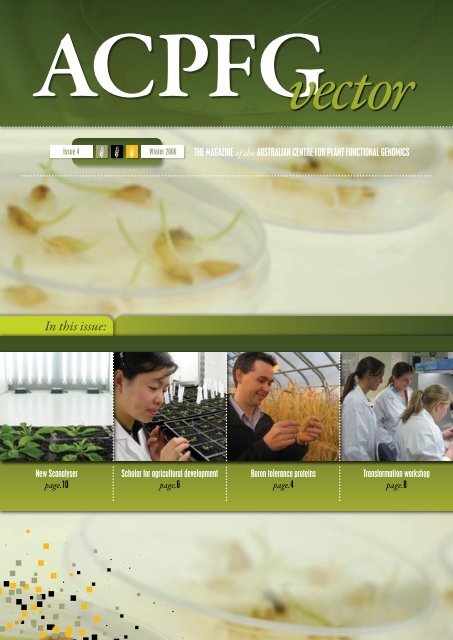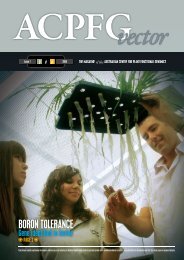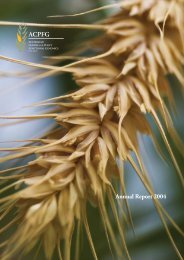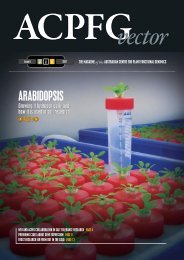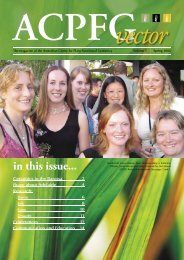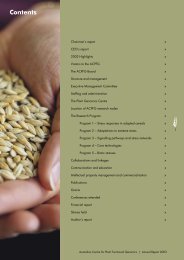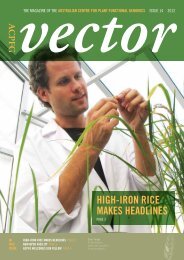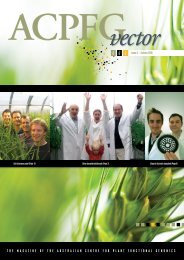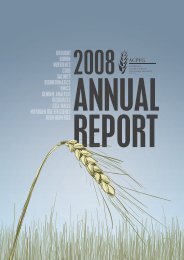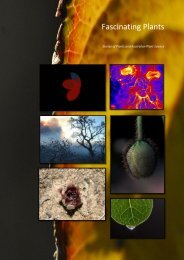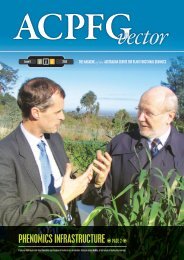Issue 4 2006 - acpfg
Issue 4 2006 - acpfg
Issue 4 2006 - acpfg
You also want an ePaper? Increase the reach of your titles
YUMPU automatically turns print PDFs into web optimized ePapers that Google loves.
ACPFG vector<strong>Issue</strong> 4Winter <strong>2006</strong>The magazine of the Australian Centre for Plant Functional GenomicsIn this issue:New Scanalyserpage.10Scholar for agricultural developmentpage.6Boron tolerance proteinspage.4Transformation workshoppage.8
ACPFG VECTOR ISSUE 4 – WINTER <strong>2006</strong>vectorThe magazine of the Australian Centre for Plant Functional GenomicsIn this issue» Page 2Page 4Page 5Page 6Page 7Page 8Page 9Page 10Page 11Page 12Page 13Page 14Page 16Page 18Symposium success near spectatular cetaceansTracking proteins for boron toleranceNavigating a maze of data with bioinformaticsTraining for agricultural developmentNew Biosafety OfficerKnowledge transformationTesting tissue strengthGentle phenotypingForum for the future of agricultural biotechnologyPlants in FranceWorld’s plant research comes to AdelaideNational Science WeekOut and about with ACPFGNew Faces
ACPFG VECTOR ISSUE 4 – WINTER <strong>2006</strong>The Victor Harbor coastlineDavid Miller from Invitrogen with Andrew Sivakumaran from the ACPFG in VictoriaDolphins and whales joined delegates on the coastSymposium success near spectacular cetaceansBy Belinda BarrIf you’re involved in moleculargenetics, genomics and geneticanalysis in the Triticeae thenVictor Harbor was the place tobe this August.Over 150 delegates attendedthe <strong>2006</strong> International TriticeaeMapping Initiative (ITMI)Workshop and ACPFG GenomicsSymposium, which ran fromthe 27th to the 31st of August atthe McCracken Country Club,South Australia.“The events brought togethersome of the top cerealresearchers from around theworld” said ACPFG CEO ProfessorPeter Langridge.The Symposium began withthe ITMI Triticeae GenomicsVision meeting on the Sunday thatfocused on developing a strategyto ensure data and information ofthe Triticeae is readily available toall researchers. A framework foraccessing international collaborationwas also discussed.The research symposium alongwith further ITMI discussionscontinued on the Monday withworld-leading researchers outliningrecent advances in geneticresearch in wheat, barley, rye andtheir wild relatives.The presentations and discussionsdemonstrated the spectacularadvances that are happeningin cereal genomics.“It was particularly excitingdiscussing how we can coordinateinternational research efforts insuch critical crop species. Weare going back to our respectiveresearch organisations toimplement these strategies” saidProfessor Langridge.As well as research presentations,the symposium includedsocial activities. Trivia games anda social quiz night allowed delegatesto take their minds off theTriticeae. Local wines and producewere a feature of the conferencedinner, held at the Currency CreekWinery Estate. A free afternoonallowed delegates to appreciatethe Victor Harbor coastline, wheresix Southern Right Whales wereseen frolicking.The Poster night, sponsored byTriticarte saw Jesse Munkvold fromCornell University awarded $200for the most outstanding poster,followed by ACPFG’s Ming Li andSteve Scofield from United StatesDepartment of Agriculture.Thanks to all who helped makethe conference a success, in particularLara Birchby the meetingmanager and Peter Langridgefor putting together such animpressive program.Tim March from MPBCRC with Darren Plett, Dr Alex Johnson, Dr Yuri Shavrukov, Joanna Sundstrom, Dr Stuart Roy andCharlotte Joergensen from the ACPFGDr Huang Chunyuan, Dr Ulrik John and Dr Alex Johnson from the ACPFGDr Andrew Jacobs, who won the Pacific Laboratory Products raffle, with Felicity Hall and Emma Habermann from PacificDr Andrzej Kilian from Triticarte with Peter Sharp from the University of Sydney’s Plant Breeding InstituteWe would like to acknowledge the following organisations for their sponsorship:
ACPFG VECTOR ISSUE 4 – WINTER <strong>2006</strong>Dr Patterson examining whole plants, a view he doesn’t usually getTracking proteinsfor boron toleranceBy Dr John PattersonACPFG scientists are using newtechniques to identify hundredsof proteins in a single experiment,helping to establish howplants respond to boron stress.As well as looking at plantgenes, ACPFG scientists researchproteins and metabolites, whichare products of gene expression.Genes encode proteins andproteins catalyse the formationof metabolites. Every aspect ofa plant’s development dependson the coordinated expression ofgenes, proteins and metabolites– as do stress responses.At the ACPFG proteomics nodeat the University of Melbourne,we use instruments called massThe Melbourne Proteomics groupspectrometers to identify andsequence proteins. This involvesisolating the protein, then choppingit up into shorter peptidesusing enzymes that recognizeparticular amino acids. The massspectrometercan then find theamino acid sequence of individualpeptides. Using this approach, wecan follow changes in the abundanceof one or a few proteins ina single experiment.What we haven’t been ableto do is compare lots of proteinsat once. This has made it impossibleto collect protein abundancemeasurements that can be linkedto both gene and metaboliteexpression data experiments.Being able to dothis would allowus to look at theplant biology atevery step of thegene to proteinto metabolitepathway.In the lastfew years, multidimensionalprotein identificationtechnologyhas beendeveloped, andgiven the nickname MuDPIT.This allows scientists to identifyhundreds of proteins in a singleexperiment. MuDPIT still usesmass spectrometry, but the proteinsare chopped up into a morecomplex mixture of peptides,and are then separated in severalmore ways. A lot of computingpower is used to identify theproteins using this technology,and our resident software guru,Andrew Cassin, has developed anumber of in-house software toolsto make this work.MuDPIT has made a bigdifference in proteomics, butit has remained difficult tocompare protein abundances indifferent samples. Recently, wehave combined MuDPIT with areagent called iTraq, which allowsus to measure and compare theamounts of proteins in up to foursamples at the same time.This new technology is helpingACPFG researchers betterunderstand how plants respondto stresses at the gene, protein andmetabolite levels. So every stepof the gene-protein-metabolitepathway is now being followed.We have recently used thisapproach to compare plantsthat are tolerant or intolerantto the element boron. Boronis essential for healthy plantgrowth and reproduction, buttoo much causes problems.We have identified interestingcandidate proteins that arepresent in different amounts indifferent plants. The role theseproteins may play in boron toleranceis now being examined– stay tuned!Dr John Patterson joined theteam at the Melbourne proteomicsnode of the ACPFG in 2003. He isa Biochemist using proteomics tounderstand how cereals respond toboron and drought stress.Dr Patterson completed hisundergraduate and postgraduatestudies at the University ofMelbourne. During his PhD in thebiochemistry department, he lookedat pathways of cell wall formationin bacteria that cause tuberculosis,leprosy and Johne’s disease.By Nikki ApplebyA bioinformatics workshop at theACPFG in Queensland demonstratedthe potential of computersin biological sciences.Functional genomics involveshandling a lot of data. In lookingat how stresses affect cerealyield, for example, scientists willgather thousands of points of datadescribing links between a plant’sgenetic blueprint, its environmentand its phenotype.The job of analysing suchlarge amounts of data is donewith computers, by turning thebiological data into a problem,solving the problem and thenconverting the results back intobiologically relevant knowledge.This is bioinformatics.Recently a five-day bioinformaticsworkshop was heldat the ACPFG’s University ofQueensland (UQ) node, led byProfessor Vladimir Brusic. Twentypeople attended the workshop,which aimed to show how toapply bioinformatics techniques toindividuals’ research problems.On the first day the participantschose a research problem in theirarea that could be solved usingbioinformatics, and then workedon their problem for the week.Participants’ research problemscovered humans, animals andplants, with topics as diverseas aluminium tolerance, breastcancer and schizophrenia.One participant wanted tolearn more about proteins in theThe bioinformatics workshops in actionbrain that appear to be involvedin schizophrenia. He discoveredbioinformatics could help byexamining published metabolicpathways involving the proteins.He also found that there wasvaluable data in existing proteinproteininteraction databases.A participant from the ACPFGwanted to find information abouta gene called ALMT1, which isinvolved in ‘mopping up’ aluminiumions in wheat. Usingbioinformatics algorithms he wasable to compare this gene’s DNAPhD student Nikki Appleby, at the ACPFG’s University of Queenslandnode, has won a prestigious award for women in technology industries.The bioinformatics student beat 150 applicants in informationtechnology, science and engineering, to win the Women in Technology(WIT) Postgraduate Research Award.Nikki said that careers in technology are now more appealing towomen than when she began studying.“The hours are more flexible than other jobs so you can make itwork for you, whether you intend to be a career specialist or embracemotherhood. There is a lot of scope to change subject areas like I have,so you never get bored!”The WIT awards aim to attract and retain women in technology,allowing winners to accelerate their careers with professional developmentand industry recognition.Navigating a maze of data withbioinformaticssequence with known genomesacross many species. He foundsimilar DNA sequences in severalplant genomes, suggesting thesequence has been conserved.Conserved sequences are oftenbiologically important as theyhave remained largely unchangedas species have evolved. Itappears this DNA sequence hasmaintained its aluminium tolerancefunction across species.Using bioinformatics, scientistscan now study biologicalproblems in silico, which makesaccessing and understanding largeamounts of data easier than everbefore. Professor Brusic emphasisedthat to use bioinformaticseffectively, it is important for scientiststo work across disciplineswith specialist co-workers. Theworkshop allowed participants totake their first steps in what mayseem a bewildering maze of dataand tools, but what is in fact afield of opportunity.Nikki Appleby is a PhDstudent with the ACPFG at theUniversity of Queensland. She isintegrating data from multiplesources to help discover novel genetargets for abiotic stress tolerancein unsequenced genomes.Nikki with the other award winners and Queensland Information Technology Policy Minister, Chris Cummins MP
ACPFG VECTOR ISSUE 4 – WINTER <strong>2006</strong>Dr Wang with Arabidopsis plantlets in a growth roomThe Gene Technology Act 2000is Australia’s federal legislationregulating gene technology.The Office of the Gene TechnologyRegulator (OGTR) manages andenforces Australia’s regulationsfor the development and use ofgene technology. It is part of theTherapeutic Goods Administration,within the federal Department ofHealth and Ageing.Dr Andrew JacobsDr Andrew Jacobs is the new Biosafety Officer forUniversity of Adelaide staff in the Plant Genomics Centre.Training for agricultural developmentBy Cobi SmithThe ACPFG is hosting a talented plantscientist from China.Dr Xiaojuan Wang is a plant scientist andAssociate Professor at Lanzhou University innorthwest China. She has joined the ACPFG inAdelaide for six months, where she is studyinggenes and loci related to low salt accumulationin Arabidopsis.Dr Wang is looking forward to the challengesof studying overseas for the first time.“Meeting people from different culturalbackgrounds will open my eyes. Also, it shouldbe a good chance to improve my English,”she said.Dr Wang’s Australian project is jointlyfunded by the Federal Government’s Australia-China Council and the Crawford Fund.The Crawford Fund gives talentedagricultural scientists from developingcountries practical training at an Australianagricultural research institute, which they canapply to agricultural development in theirhome county.Dr Wang will be passing on knowledgegained at the ACPFG to students when shereturns to China.“I have completed the ACPFG TransformationWorkshop and am starting myexperiments on salt tolerance. My time atACPFG will strengthen my knowledge of DNAtransformation and molecular mechanisms insalt tolerance, as well as giving me practicaltraining,” she said.In China, Dr Wang has been investi-gating the genetic diversity of alfalfagermplasm in arid and semi-arid areas usingmolecular markers.In 2005 she worked on a project with theAustralian Centre for International AgriculturalResearch, collaborating with South Australianresearchers to develop lucerne adapted toharsh conditions in China and Australia.Dr Wang is now working in Professor MarkTester’s lab with the support of Dr Stuart Roy.“I hope my six month visit to the ACPFGis the start of more collaboration betweenthe ACPFG and Lanzhou University. Ouruniversity encourages us to establish links withlaboratories overseas, so I hope people fromthe ACPFG will come to Lanzhou Universityin the future,” she said.What are your main responsibilitiesas the Biosafety Officer?Ensuring everyone that comes towork here is aware of and adheresto the regulations of the GeneTechnology Act, 2000.I have to make sure people aretrained in the use of gene technology,so they understand theresponsibilities and proceduresinvolved in working with geneticallymodified material in ourphysical containment facilities.I also answer staff queriesabout using, handling and transportinggenetically modifiedorganisms (GMOs) in line withOGTR regulations.As well as training and assistingour staff, I’m involved in reviewingbiosafety aspects of newresearch projects and liaising withthe University of Adelaide’s InstitutionalBio-safety Committee.What do you feel is yourgreatest responsibility as theBiosafety Officer?I take very seriously the task ofensuring the ACPFG is able to continueits work in the area of geneticmanipulation by making sure wecomply with the regulations.This is best achieved by educatingthose who are using thiskind of technology, so that’s mygreatest responsibility.How do these responsibilities fit inwith your existing workload?Much of my day-to-day workinvolves the use of GMOs andthis is an area that I have workedin for the past 13 years, so myexperience with and understandingof the issues is good.Whilst the responsibilitiesof educating newcomers andmonitoring the centre’s geneticmodification (GM) work willundoubtedly keep me frommy experiments at times, itdoes allow me to keep abreastof developments in the area bothat the ACPFG and more widelyin Australia.Thankfully our LaboratoryManager, Jan Nield, takes onsome of the occupational healthand safety responsibilities thatwould otherwise be mine as theBiosafety Officer.How can other staff help you do thisrole most effectively?By doing GM work according tothe book. People should be awareof their responsibilities and goabout their work accordingly.If people are unsure aboutanything to do with biosafety theyshould consult me prior to startingtheir experiments.
ACPFG VECTOR ISSUE 4 – WINTER <strong>2006</strong>Dr Keith Gatford guiding workshop participants through a practicalJillian with the Instron machineKnowledge transformationDr Marilyn Henderson reports on her experience at the ACPFG Transformation Workshop held 17th to 21st July <strong>2006</strong>.By Dr Marilyn HendersonI have been ‘transformed’ froman Animal Physiologist to a PlantMolecular Biologist.Well not quite! However,I did recently complete theACPFG’s five-day TransformationWorkshop, at the University ofAdelaide’s Waite Campus.Working on the periphery of somany exciting research programsI have become familiar with theterminology and techniques ofgenetic modification. I decidedhowever, that it was high time tofill some of the gaps in my knowledgebase in relation to geneticDr Marilyn Henderson pipetting, watched by other participantsengineering technology and thisworkshop was the answer.I was not the only curiousscientist: this year the workshophad record attendance, withtwenty participants from differentdisciplines. There werealso early career scientists whoplanned to use transformation intheir research.The workshop also attracteddecision makers from governmentand funding bodies, who wantedto get a better understanding ofthe science they were makingdecisions about.We covered both theoreticaland practical aspects of planttissue culture, transformation ofcrops and model plants, molecularanalysis of transformed plants andevaluation of transgenic material.We had lectures on the useof vectors, promoters, enhancertraps and selectable markers,functional analysis of genes andgene discovery techniques.The lecture series also coveredcurrent applications ofgene technology, problems andsolutions in plant tissue cultureand transformation experimentsand regulation of geneticallymodified crops in Australiaand worldwide.This workshop was a verygood investment of a week ofmy time and I would recommendit to anyone interested ingenetic modification.Dr Marilyn Henderson joinedthe ACPFG more than two years ago,starting in administration. She has aBachelor of Agricultural Science, aGraduate Diploma in EnvironmentalStudies and a PhD in Animal Science,from the University of Adelaide.She worked in anatomy, histologyand pathology before finding herniche in electron microscopy. Sheworked in the Centre for ElectronMicroscopy and MicrostructureAnalysis, now called AdelaideMicroscopy, for about 20 years.She now works with severalgroups within the ACPFG, usingmicroscopy skills to identify thelocation of specific cell componentsor expression components usingimmunogold labelling or otherhistological techniques.TestingTISSUE strengthBy Jillian TaylorThe content of plant cell wallscan impact plants’ productivityin agriculture.For example in maize, stemstrength is linked to cellulosecontent, so increasing celluloselevels in maize could affectimportant properties such aslodging and digestibility.To learn more about cellulosecomposition of cell walls, theFincher lab has purchased aseries 5543 Instron. This machineapplies force to plant tissue, thenmeasures the amount of forcerequired to bend, tear, snap,stretch or puncture the samples.This machine will help usinvestigate mechanical propertiesrelating to tissue strength in maize,barley and Arabidopsis. We canthen correlate this knowledge withinformation gained from transcriptprofiling, to better understand cellwall composition.The ACPFG Instron canbe used by researchers fromother organisations. Contactjillian.taylor@<strong>acpfg</strong>.com.au formore information.Jillian Taylor’s profile is onpage 19.Cellulose is a complex carbohydrate presentin cell walls that helps make plant stems strong.Lodging is when cereal crops fallover, often due to wind or rain pressure,making grain harvest difficult.Transcript profiling can identify differentribonucleic acids (RNA) produced in a cell, whichindicates if particular genes are expressed.
ACPFG VECTOR ISSUE 4 – WINTER <strong>2006</strong>ACPFG Chair Nick Begakis AM, Dr Stephanie Agius, Alexandra Smart, Sarah Morran and Sushma Ramesh from the ACPFG, at the Waite standGentle phenotypingBy Dr Trevor GarnettThe ACPFG has bought aLemnatec Scanalyser, a state ofthe art plant imaging and imageanalysis unit.The system has two camerasand a rotating turntable for takinghigh quality images of plants fromthree perspectives. The imagesare then analysed by two computersto give measurements suchas plant height, leaf area, leafarchitecture and leaf colour.The Scanalyser will benefitACPFG research because it cangive a non-destructive estimateof plant biomass. At present if youwant to measure plant biomassyou have to cut the plant up andweigh it. This is not very helpful ifyou need the plant to be alive.The system can also give veryuseful information about planthealth. When a plant is sufferingfrom something like salt toxicity,the symptoms include a yellowingof leaves and burning of the leaftips. The Scanalyser allows usto quickly estimate the leaf areaaffected so we can easily compareplants that may have differentsalt tolerance.The Scanalyser is an importantstep forward in plant phenotyping.Many of the approaches toimproving plant stress tolerancerequire picking relatively subtledifferences between plants andthe Scanalyser allows us to do thisrapidly without damaging them.The ACPFG Scanalyser canbe used by researchers fromother organisations. Contacttrevor.garnett@<strong>acpfg</strong>.com.au formore information.Dr Trevor Garnett managesthe ACPFG’s nitrogen use efficiencyproject. He is a Plant Physiologistspecialising in plant nutrition.Phenotyping is observing differencesin plants’ appearances, due to both theirgenetic makeup and environment.Matthias Eberius from Lemnatecin Germany explaining to Dr StuartRoy how the Scanalyser worksForum for the future of agricultural biotechnologyBy Dr Stephanie AgiusThe ACPFG teamed up with Waiteorganisations for an exhibit at the<strong>2006</strong> Agricultural BiotechnologyInternational Conference (ABIC),in Melbourne this August. Thiswas the first ABIC conference inthe Southern Hemisphere.The <strong>2006</strong> conference hadthe theme, “unlocking thepotential of agricultural biotechnology”,focusing on innovationand commercialisation.The aim was to create a forum tointroduce technologies developedby world-renowned scientists toindustry partners and investors inagricultural biotechnology.The ACPFG was well representedin the program, withProfessor Peter Langridge presentingand Michael Gilbert chairinga session. Marie Thorpe also rana Get into Genes workshop in theABIC education session.Ten ACPFG representativesfrom South Australia and Victoriahelped with the Waite stand,which highlighted the growthof South Australia’s food andwine industries.The stand was shared by theAgriculture (Food and Wine)Alliance, which representsorganisations on the Waitecampus, as well as the SouthAustralian Government.It emphasised the Waite’sresearch capabilities, withexpenditure in excess of $120million and exports worth over$3 billion annually.This year’s conference marksthe tenth anniversary of thebiennial ABIC conference. Theconference will now become anannual event and will have a threeyear rotation between Europe,Asia Pacific and North America.The next conference will bein Calgary, in Western Canada,next September.Dr Stephanie Agius isCommercialisation Officer at theAustralian Centre for Plant FunctionalGenomics. She has a PhD in plantmitochondrial physiology from theUniversity of Lund, Sweden and aMasters of Science and TechnologyCommercialisation Degree fromthe University of Adelaide. Shespecialises in commercial strategyfor agricultural biotechnology andintellectual property management.1011
ACPFG VECTORISSUE 4 – WINTER <strong>2006</strong>Fleur and Jenna in Chamonix, on Mount Blanc, the highest mountain in France.Plants in FranceBy Jenna Malone and Fleur DolmanIn July we travelled to Francefor the 15th Federation ofEuropean Societies of PlantBiology (FESPB) Congress, inLyon. The congress coveredclassical plant physiology andapplied plant biotechnologiesunder the theme ‘plants, peoples,ecosystems and applications’.We found the presentationswere fortunately much betterthan the ‘French gastronomy’served for lunch and dinner.The sessions on plant neutraceuticalsand biofortificationwere interesting, in particulara presentation by WilhelmGruissem from the Swiss FederalInstitute of Technology inZurich. This highlighted theimportance of biotechnology,especially for the future sustainabilityof food production.The session on interactionswith the environment and signallingmechanisms in response toabiotic stress was most relevantto our work and was a goodopportunity to speak with otherresearches in our field.The posters we presentedgenerated discussions withresearchers from many differentareas, often using similar experimentaltechniques. We foundthey were more than willingto share their knowledge andexperience, providing us withnew ideas to pursue and solutionsto old problems.While in Europe we alsovisited other plant biotechnologyinstitutions, including theMax Planck Institute in Cologneand the John Innes Centre andSainsbury Laboratory in Norwich.We also managed to squeeze in abit of sightseeing in Paris, shoppingin Milan and hiking (less‘Cliffhanger’, more ‘Sound ofMusic’ style!) in the French Alps(see photo above).The next FESBP Congress willbe in Tampare, Finland, in August2008. We highly recommend it!Jenna Malone has a Bachelorof Biotechnology with Honours fromFlinders University and is two yearsinto her PhD with the ACPFG. She isdetermining the role of candidategenes in plant stress responses.She is involved in ACPFG educationand communication events, as wellas practical demonstrating for theUniversity of Adelaide.World’s plant researchcomes to AdelaideAn open reading frame(ORF) is a portion of DNA orRNA that contains a sequenceof bases with an identifiablestart and finish, which couldpotentially encode a protein.Joanna Sundstrom has recentlybegun a PhD at the ACPFG in the saltfocus group. She is characterisingthe high affinity potassium andsodium uptake transport (HKT) genefamily and its regulation processes inrice and Arabidopsis. HKT genes areinvolved in sodium transport so playa role in plant salinity tolerance.By Joanna SundstromThe 8th International Congressof Plant Molecular Biology(ISPMB) was held at the AdelaideConvention Centre this August.It is the first time the ISPMB congresshas come to the SouthernHemisphere and attracted closeto 1200 delegates from morethan 40 countries.The wide variety of researchhappening at the ACPFG was wellrepresented and communicatedthrough several talks and over 30posters produced by research staffand students.As an early career PhD student,the ISPMB conference was bothan inspiring and overwhelmingexperience. With five dayspacked full of interesting talks, notonly was there an opportunity tohear of current research inmy field, there were also manyopportunities to both extendknowledge in other areas of personalinterest and be exposed tonew fields and techniques. It wasoften difficult to decide which ofmany concurrent talks to attend.Professor Joseph Ecker fromthe Salk Institute for BiologicalStudies in California gave aninteresting talk about analysis ofthe Arabidopsis thaliana genome.His lab participated in sequencingthe Arabidopsis genome andis now involved in cataloguingprotein coding and non-codingopen reading frames (ORFs).I also enjoyed the sessionson “biotech prospects froma global perspective” and“metabolic engineering forproduct quality”. These sessionsillustrated how having a soundunderstanding of plant systemscan allow plants to become themanufacturing systems for usefulproducts like vaccines, plasticsand polyester.Being a part of the <strong>2006</strong> ISPMBcongress was a fantastic opportunityto witness the vast amount ofplant research happening aroundthe world. The opportunity toattend the conference was yetanother benefit of being a PhDstudent at the ACPFG.Inside the Auditorium Lumière of the Lyon Palais des Congrès, where plenary sessions were held.Fleur Dolman is completingher PhD at the ACPFG, studying plantcytosolic thioredoxins. She is alsoinvolved in ACPFG education andcommunication events. Fleur hasa Bachelor of Biotechnology fromFlinders University with Honours, forwhich she studied kinase signallingcascade genes in grapevines.The ACPFG were Gold Sponsors of the 8th International Congress of Plant Molecular Biology held in Adelaidethis year. Through this sponsorship ACPFG gained valuable exposure to national and international delegates,with many stopping by to discuss plant molecular biology at the ACPFG booth in the exhibition hall.1213
ACPFG VECTOR ISSUE 4 – WINTER <strong>2006</strong>Education officer Marie Thorpe headedout to Benalla in country Victoria,to deliver Get into Genes duringNational Science Week. Basedat Benalla College for two days,she presented the workshop tomore than 70 students from threeregional schools.Marie said it’s important forGet into Genes to reach ruralareas so students can fulfil DNAlearning requirements in theircurriculum.“City schools have lots ofoptions, and rural and regionalschools often miss out. There’sa big need for these sessions incountry schools,” she said.The ACPFG and MPBCRC again hosteda quiz night at Mawson Lakes,called Beer – Barley to Bottle. Itincluded four presentations onbeer making, with beer tastingsand prizes.The mystery beer was XXXXGold, which every table guessedwas an exotic European importworth twice the price. Thiseither demonstrates that SouthAustralians regard XXXX as foreign,or that it’s underrated!National Science Week 06What do you get when you cross abunch of scientists, some microphones,a heap of community membersasking tough questions and a pub?Science in the pub!Science in the Pub is a NationalScience Week event that aims tobring science and the public closertogether through encouraged scientificdiscussion over a meal anda drink. It’s a great public forumfor scientific debate.This year, ACPFG PhDstudent Alexandra Smart andCommunications and EducationManager Belinda Barr trekked upto Melrose in the Finders Rangesto sit on the panel with threeother scientists. More than 60community members then firedscience related questions at thepanel for two hours.Alexandra won the crowd overwith a DNA extraction experimentand answered questions aboutplant biotechnology researchwith ease.The event helped raise awarenessof the technologies usedto develop improved cerealcrops, while giving us aninsight into community views ongene technology.Science came alive in Adelaide on August 13th, with thelaunch of Adelaide’s new annual science festival, Science Alive!The family science spectacular featured more than 30 hands-on stalls,with more than 11,000 people touching, feeling and experiencingall things science.The ACPFG and MPBCRC ran the Gene Juice Bar, where DNAexperiments sold like hot cakes. In fact, Belinda Barr and Cobi Smithled the public through 700 experiments in six hours.The event’s success means it will now be held annually at theRoyal Adelaide Show Ground.Cobi Smith and Belinda Barr with the Gene Juice Bar at Science Alive!Belinda Barr teaching a showgoer about glutenACPFG PhD student Darren Plett headedto Brisbane for EKKA, the RoyalQueensland Show, where hepresented a daily talk on salttolerance in crops, called ‘a goodroot relieves stress’, followed byDNA extractions.Darren’s presentation wasbefore the catwalk modelling,so by the end of each session hehad a full house, with the chanceto introduce DNA to peopleotherwise uninterested inscience. Darren said this wasn’tthe only benefit of sharing spacewith the models.ACPFG and MPBCRC representatives worked at the Royal AdelaideShow on the joint display, ‘CSI: Crop Science Investigators’.The display in the Golden Grains Pavilion showed how to extractDNA from plant tissue. It also had an interactive dough displayhighlighting the role gluten plays in bread making.1415
Out and aboutWITH ACPFGFunDr Heather Bray from MPBCRC, Bruce Stevens from Education Queensland, Dr Amanda Ablefrom MPBCRC and Belinda Barr from the ACPFG at the awards ceremonyGet into Geneswins national awardBy Belinda BarrThe ACPFG and Molecular Plant Breeding Cooperative ResearchCentre joint education program, Get into Genes, has receiveda Cooperative Research Centres Association (CRCA) Award forExcellence in Innovation.The award recognises Get into Genes’ innovative approach ingiving secondary school students and teachers relevant examplesof gene technologies used to develop improved cereal crops.Gene technology is a major component of secondary schools’biology curriculum. Generally students learn about these technologies,such as DNA fingerprinting, through medical and forensicexamples. Through Get into Genes students are made awareof the role gene technology also plays in developing improvedcereal crops.The workshop aims to increase students’ understanding of plantbiotechnology and ultimately attract high quality undergraduatestudents to plant biotechnology.Get into Genes is a product of three years research and development.It has been designed with teacher input to ensure it meetsboth students’ and teachers’ learning objectives, while givingworking, contextual research examples.In the workshop students learn about how DNA is used in aplant breeding program, from marker assisted selection to geneticengineering. Students also investigate conventional plant breeding,DNA extraction, gel electrophoresis, restriction enzymes andmolecular markers.Get into Genes has been successfully run in South Australia atthe Plant Genomics Centre since 2004. It is now being deliveredin Victoria at the Victorian AgriBiosciences Centre at La TrobeUniversity and the University of Melbourne. Well over 3500students have been through the workshop since its inception.The Awards for Excellence in Innovation ceremony was held inBrisbane in May as part of the national CRCA conference.Careers onlineThe new Transform Your Career resourceThe ACPFG’s new careers site, aresource for secondary and tertiarystudents, is now online. Thesite aims to give students an ideaof the opportunities and experiencesthey can expect from ascience career, as well as how theycan prepare for their ideal job.The site has interviews with10 ACPFG staff in a range ofHannah from Annesley College in an ACPFG labBy Dr Stuart RoyThe ACPFG is once again takingpart in the CSIRO studentresearch scheme, which aims toget year 12 students enthusiasticabout careers in science.This year we have Hannah andMichelle from Annesley College,who are investigating the differencesin gene expression betweencells of the inner and outer halvesareas, such as protein chemistry,bioinformatics, microscopy andcommercialisation.The interviews revealed someinteresting facts about ACPFGstaff, such as:• Dr Rachel Burton started acareer in medical microbiologybefore realising her passion wasplant science• If Nadim Shadiac weren’t aprotein chemist he’d be anAustralian football star• Dr Andreas Schreiber has moreexperience in subatomic physicsthan bioinformatics• David Harris’s colourful historyincludes working as a plumber’smate and carpenter’s assistant.www.<strong>acpfg</strong>.com.au/careersStudents in scienceof the root, and examining howgene expression affects the transportof salt to the shoot.After their four afternoonsat the ACPFG, they will givea presentation about their workto schoolmates and design aposter that will be judged byother members of the studentresearch scheme.Gwen, Stu and the amazingtechnicolour lab coatIn June the Plant Genomics Centre participated in the World’s BiggestMorning Tea, raising almost $800 for cancer research. As part ofthe fundraising events, staff members were encouraged to offer atalent or item for auction. Researcher Gwen Mayo offered her artisticpainting services.Scotsman, Dr Stuart Roy, won the bidding and is now proudly wearinga lab coat sporting a fantastic painting of the Loch Ness monster wearinga hat in Dr Roy’s ancestors’ tartan, pictured.Due to popular demand Gwen will offer her painting services forcharity again next year.Plant Genomics Centre World CupBy Nadim ShadiacACPFG staff embraced theAustralian Socceroos’ entry inthe World Cup with a local soccertournament. One thing’s forcertain… despite our Braziliannicknames, we were no Brazil!A bunch of soccer enthusiaststook to the Waite Oval on a coolThursday afternoon to showcasesome of the ACPFG’s emergingtalents. Four teams with a total of28 players battled it out for a littleover an hour, in what seemed likean eternity.The goalkeepers provided somethe best highlights with outstandingdiving saves including a crackingshot that was denied by the noseof keeper Trevor Garnett.Despite allegations of matchfixing, the winning team, theDaring Dodgers (who acquired ahandy player, me, for the secondhalf) were bathed in glory aftergoing through to the final on apenalty shootout.Gwen putting the finishing touches on Stu’s lab coatand games on the field16 17
New FacesAT ACPFGHeath WhiteI recently graduated from FlindersUniversity with a Bachelor ofBiotechnology with Honours.My research project involved analysingthe effect of alternative oxidaseRNAi knockouts on salinity stressin tobacco.The ACPFG provided me with awonderful opportunity to do my PhDon a topic which I truly love – abioticstress in plants. I am now part of thedrought focus group, working to identifyand characterise the substrates ofseveral maize histidine kinases andmitogen-activated protein kinases andtheir wheat orthologs.I look forward to continuing workon this exciting project over thecoming years and with a lot of hardwork (and a touch of serendipity) hopeto make some exciting discoveries.New FacesAkiko EnjuDuring my undergraduate years atTokyo Gakugei University, I obtaineda Bachelor of Biology and a secondaryschool teacher’s license in science.I completed a Master of BiologicalScience at the University of Tokyo,looking at expression and enzymaticproperties of two acyltransferaseisozymes in squash, which determineArdashir KharabianI was born and raised in Rasht,a green city in the north of Iran. Ireceived a Bachelor of Science,focusing on agricultural engineering,agronomy and plant breeding, fromAzad University.I completed a Master of Sciencein plant breeding and worked as alecturer and researcher in geneticssaturated and unsaturated fatty acidcontent of glycerolipid in plastid.After my master, I worked inProfessor Shinozaki’s lab in RikagakuKenkyusho (Institute of Physical andChemical Research, Japan) as atechnical officer and was involvedin a plant functional genomicsproject. In 2004 I visited Sydneyand plant breeding at Azad University,for more than eight years. My mainarea of expertise is plant molecularcytogenetics. I have published injournals including Plant Cell, Tissueand Organ Culture.In March <strong>2006</strong> I arrived inMelbourne with Australian permanentresidency. I contactedand Melbourne on holidays, whichmade me want to live in Australia.Finally my dream has cometrue. I have joined the ACPFG as aresearch officer, working on nitrogenuse efficiency. I am very happyto work with friendly and helpfulpeople in this lovely environment.Dr Thorsten Schnurbusch about hisdrought project, which led to somework with the ACPFG in Adelaide.Now I am proudly pursuing my PhDon quantitative trait loci mappingof drought-related traits in doublehaploid wheat.Dr Helen O’SullivanI have a Bachelor of Science withHonours in Biology from CardiffUniversity in the UK. My researchproject involved identifying maizeplants with a Mutator (Mu) transposableelement in their beta-tubulin genes.This research took me back toEngland to work at the beautiful LongAshton Research Station (LARS) inBristol. At LARS I screened a largecollection of maize plants containingMu insertions and identified mutantDr Imran MalikI am originally from Dhaka, the capitalof Bangladesh. There I obtaineda Bachelor of Science with Honoursand a Master of Science in Botanyfrom the University of Dhaka.In Dhaka I worked on lentilmicropropagation, before going tothe University of Canterbury in NewZealand. I then went to the Universityof Western Australia, where I did aPhD on physiological responses ofwheat to water logging.plants which were further characterisedback in Cardiff.After my undergraduate degreeI spent a year travelling the world,which was an amazing experience.After I had run out of money I returnedto LARS as a research assistant, whereI developed molecular markers inmaize. When LARS closed in 2003our group moved to Bristol University,where I obtained my PhD in associationgenetics in wheat.I stayed at the University ofWestern Australia to work on a projectfunded by the Grains Research andDevelopment Corporation, with theCooperative Research Centre forDryland Salinity, researching wheattolerance to salt and waterlogging.The project uses wide crosses ofwheat and Hordeum marinum, a wildrelative that is very tolerant. I amresearching physiological responsesunder salinity and waterloggingDuring my PhD I attended aconference in Adelaide on linkagedisequilibrium. I was given a tourof the Plant Genomics Centre andthought it was a very exciting placeto work. So on returning to the UKI applied for the Wain InternationalTravel Fellowship, and here I am!I will be at the ACPFG for ayear, assessing the level of linkagedisequilibrium on chromosome 3Dof wheat.stresses, with a focus on aerenchymaformation and radial oxygen loss fromthe roots and regulation of leaf ionconcentrations.I am at the ACPFG studying sodiumion fluxes under combined stress ofsalinity and waterlogging in thesespecies. I am excited at having theopportunity to work at this centre andfeel very welcomed by the group.Benkush MehtaI am originally from Punjab in India,where I obtained my Master ofBiochemistry with genetics and biotechnologyas minor and chemistryas supporting. My undergraduatedegree focused on chemistry, botanyand zoology.During my Master I researchedsugarcane and wrote my thesis onsoluble invertase isoenzymes inrelation to sucrose storage andmaturity behaviour.After my degree I married andmoved to Adelaide, where I beganas a casual with the South AustralianResearch and Development Institute.I was very happy to join the ACPFG,where I’m working with Dr MariaHrmova as a volunteer, before startinga permanent position in January.Lindsay ProdeaI graduated from the Norwood MorialtaHigh School in 2003 and am currentlya third year students at FlindersUniversity, completing a Bachelor ofBiotechnology with Honours.I’ve come to the ACPFG for twoweeks in July for an industry placement,a supplement to my studies.During this time I’m working in thelab of Dr Sergiy Lopato, supervisedby PhD students Sarah Morran andHeath White.I’m very excited to experiencesome of the fields that will be availableto me when I finish my degree!Charlotte JoergensenLast year I completed a Bachelor ofAgriculture at the Royal Veterinaryand Agricultural University inCopenhagen, the capital of Denmark.I did a research project on cyanogenicglucosides and nitrile glucosides inthe species Lotus and Rhodiola.I am now doing my Master ofAgriculture, specialising in cropproduction and protection. For thepast 5 months I have been examiningthe effects of sulphur starvation onphotosystems in rice.As a part of my education I havechosen to work as a volunteer at theACPFG for 10 weeks. I will primarilybe looking at nitrogen use efficiencyin maize, supervised by TrevorGarnett. Hopefully I will improve myskills in the lab, learn new techniques,improve my English and meet somenice people.Jillian TaylorI completed a Bachelor of Scienceat Flinders University, majoring inmolecular biology. Prior to my degreeI worked at the Waite Campus forseveral years on a range of projectsfrom cereal cyst nematode resistancein barley, to molecular analysis ofaphid saliva.I spent time working on doublehaploid barley, where my loveof plant tissue culture led me totry a year in Darwin working in aculture laboratory associated withthe cut flower industry. We workedpredominantly with orchids and Ilearnt a lot, but the laboratory wasin a small rainforest with roamingpythons, and after one was shot foreating two of the manager’s chickenswhole, I thought it was time to returnto the safety of Adelaide.I am really enjoying working backat the Waite Campus and especiallyenjoy the friendly, productive atmospherehere at the ACPFG.18 19
New FacesNataliya KovalchukI grew up in Rivne in western Ukraine,moving to the capital, Kyiv, for university.I received a Bachelor of Scienceand PhD in plant physiology from theNational Taras Shevchenko University.As an undergraduate in the Kyiv Instituteof Botany I cloned cranberries, whilefor my PhD I studied phytohemag-glutinin in seeds.Still at the institute I became asenior research scientist, examiningthe role of lectins in the hormonalregulation of plant growth. For thepast few years my main researchinterest has been the physiologicalfunctions of seed lectins inplant responses to abiotic stresses.I recently arrived in Australia,where I am working on improvinggrain quality and yield by altering theexpression of regulatory genes. I amlooking forward to contributing myexperience and enthusiasm to theACPFG team.Sam HendersonI studied Biotechnology at FlindersUniversity. After completing myundergraduate degree I took a year offand worked as a laboratory technicianin a winery in McLaren Vale, beforetravelling around Australia.Last year I did my Honours at theAustralian Wine Research Institute,examining the potential of Botrytiscinerea aspartic proteases to preventhaze in bottled white wine.At the ACPFG I have been workingin Professor Geoff Fincher’slab with Dr Rachel Burton on arange of projects involving barleygene expression.Tatiana PyvovarenkoI am originally from Kyiv in theUkraine, where I completed a sciencedegree majoring in virology. I thenjoined the Institute of Biochemistryand Physiology of Microorganisms,of the Russian Academy of Sciences,to complete my PhD.There I studied genetic determinantsof antibiotic resistance in lacticacid bacteria, constructing geneticmaps of R-plasmids and creating shuttlevectors for industrial strains.I moved to Australia in 1996 withmy family. I worked for several yearsin a private diagnostic companyas the molecular biology sectionsupervisor, developing and applyingnew molecular diagnostic tests forbacterial and viral infections as wellas genetic disorders.I joined the ACPFG in March <strong>2006</strong>as a research officer to look at expressionof stress-inducible transcriptionfactors from drought-tolerant varietiesin maize. I am delighted to be part ofthe ACPFG team.Zahra ShoaeiI completed a Bachelor of PlantProtection at Zanjan University inIran. After my degree I stayed at theuniversity as a research assistant,identifying cultivars of potato resistantto a soil-born fungal disease. I alsoworked with an agricultural group ona wheat yield improvement project inZanjan province.After I got married I moved toAdelaide with my husband, whois doing PhD at the University ofAdelaide. I like Adelaide, especiallyits friendly people and nice weather.I’m very happy I’ve had the chance todo work experience in Professor MarkTester’s lab at the ACPFG.The ACPFG vector is a quarterly publication.Contributions, comments and queries arewelcome. If you have any information onACPFG news, events, research or internationaltravel that should be included in the next issue,please contact:Amanda Hudswell, Communications OfficerEmail: amanda.hudswell@<strong>acpfg</strong>.com.auPh: (08) 8303 7230Fax: (08) 8303 7102For more ACPFG news and information, go to:www.<strong>acpfg</strong>.com.auAmanda HudswellIn my early days I completed aBachelor of Science at the Universityof Adelaide with majors in Botanyand Psychology. This led me towork in a bank for six years! Here, Idiscovered my enthusiasm lay in theareas of publicity, communicationand event/project management. SoI enrolled in a Graduate Diploma inCommunications (Public Relations)at the University of South Australiawhich I completed in 2003.Since early 2002 I have been workingin Communications, Marketingand Public Relations consultanciesand at UniSA. My most previous roleinvolved me writing tender and grantapplications, assisting in winning anumber of high profile tenders andgrants for UniSA.Between 1997 and 2004 I waslead singer in acoustic duo Trystperforming both original and coversongs. To quench my thirst for musicnowadays, I emcee Karaoke nights ata local Adelaide pub.I didn’t always know that communicationwas my passion, but I’mglad I found it.The ACPFG gives no warranty and makesno representation that the information inthis document is suitable for any purpose oris free from error. The ACPFG accepts noresponsibility for any person acting or relyingon the information contained in this document,and disclaim all liability for any loss, cost orexpense incurred by reason of any person usingor relying on the information contained in thisdocument or by reason of any error, omission,defect, or mis-statement contained therein.20
vector The magazine of the Australian Centre for Plant Functional GenomicsAustralian Centre for Plant Functional GenomicsPMB 1, Glen Osmond, South Australia 5064To subscribe to Vector, the ACPFG magazine, send an emailto reception@<strong>acpfg</strong>.com.au with your address and ‘subscribeto Vector’ in the subject, or post to the address above.


